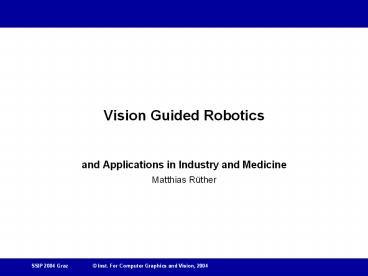Vision Guided Robotics - PowerPoint PPT Presentation
Title:
Vision Guided Robotics
Description:
... 3-D Positioning of Surgical Instruments in Robotized Laparoscopic Surgery Using Visual Servoing ... make more intelligent 'surgical assistants' possible. ... – PowerPoint PPT presentation
Number of Views:616
Avg rating:3.0/5.0
Title: Vision Guided Robotics
1
Vision Guided Robotics
- and Applications in Industry and Medicine
- Matthias Rüther
2
Contents
- Robotics in General
- Industrial Robotics
- Medical Robotics
- What can Computer Vision do for Robotics?
- Vision Sensors
- Issues / Problems
- Visual Servoing
- Application Examples
- Summary
3
Robotics
- What is a robot?
- "A reprogrammable, multifunctional manipulator
designed to move material, parts, tools, or
specialized devices through various programmed
motions for the performance of a variety of
tasks" - Robot Institute of America, 1979
- Industrial
- Mostly automatic manipulation of rigid parts with
well-known shape in a specially prepared
environment. - Medical
- Mostly semi-automatic manipulation of deformable
objects in a naturally created, space limited
environment. - Field Robotics
- Autonomous control and navigation of a mobile
vehicle in an arbitrary environment.
4
Robot vs Human
- Robot Advantages
- Strength
- Accuracy
- Speed
- Does not tire
- Does repetitive tasks
- Can Measure
- Human advantages
- Intelligence
- Flexibility
- Adaptability
- Skill
- Can Learn
- Can Estimate
5
Industrial Robot
- Requirements
- Accuracy
- Tool Quality
- Robustness
- Strength
- Speed
- Price Production Cost
- Maintenance
Production Quality
6
Medical (Surgical) Robot
- Requirements
- Safety
- Accuracy
- Reliability
- Tool Quality
- Price
- Maintenance
- Man-Machine Interface
7
What can Computer Vision do for Robotics?
- Accurate Robot-Object Positioning
- Keeping Relative Position under Movement
- Visualization / Teaching / Telerobotics
- Performing measurements
- Object Recognition
- Registration
Visual Servoing
8
Vision Sensors
- Single Perspective Camera
- Multiple Perspective Cameras (e.g. Stereo Camera
Pair) - Laser Scanner
- Omnidirectional Camera
- Structured Light Sensor
9
Vision Sensors
- Single Perspective Camera
10
Vision Sensors
- Multiple Perspective Cameras (e.g. Stereo Camera
Pair)
11
Vision Sensors
- Multiple Perspective Cameras (e.g. Stereo Camera
Pair)
12
Vision Sensors
- Laser Scanner
13
Vision Sensors
- Laser Scanner
14
Vision Sensors
- Omnidirectional Camera
15
Vision Sensors
- Omnidirectional Camera
16
Vision Sensors
- Structured Light Sensor
Figures from PRIP, TU Vienna
17
Issues/Problems of Vision Guided Robotics
- Measurement Frequency
- Measurement Uncertainty
- Occlusion, Camera Positioning
- Sensor dimensions
18
Visual Servoing
- Vision System operates in a closed control loop.
- Better Accuracy than Look and Move systems
Figures from S.Hutchinson A Tutorial on Visual
Servo Control
19
Visual Servoing
- Example Maintaining relative Object Position
Figures from P. Wunsch and G. Hirzinger.
Real-Time Visual Tracking of 3-D Objects with
Dynamic Handling of Occlusion
20
Visual Servoing
- Camera Configurations
End-Effector Mounted
Fixed
Figures from S.Hutchinson A Tutorial on Visual
Servo Control
21
Visual Servoing
- Servoing Architectures
Figures from S.Hutchinson A Tutorial on Visual
Servo Control
22
Visual Servoing
- Position-based and Image Based control
- Position based
- Alignment in target coordinate system
- The 3D structure of the target is rconstructed
- The end-effector is tracked
- Sensitive to calibration errors
- Sensitive to reconstruction errors
- Image based
- Alignment in image coordinates
- No explicit reconstruction necessary
- Insensitive to calibration errors
- Only special problems solvable
- Depends on initial pose
- Depends on selected features
End-effector
target
Image of end effector
Image of target
23
Visual Servoing
- EOL and ECL control
- EOL endpoint open-loop only the target is
observed by the camera - ECL endpoint closed-loop target as well as
end-effector are observed by the camera
EOL
ECL
24
Visual Servoing
- Position Based Algorithm
- Estimation of relative pose
- Computation of error between current pose and
target pose - Movement of robot
- Example point alignment
p1
p2
25
Visual Servoing
- Position based point alignment
- Goal bring e to 0 by moving p1
- e p2m p1m
- u k(p2m p1m)
- pxm is subject to the following measurement
errors sensor position, sensor calibration,
sensor measurement error - pxm is independent of the following errors end
effector position, target position
26
Visual Servoing
- Image based point alignment
- Goal bring e to 0 by moving p1
- e u1m v1m u2m v2m
- uxm, vxm is subject only to sensor measurement
error - uxm, vxm is independent of the following
measurement errors sensor position, end effector
position, sensor calibration, target position
p1
p2
u1
v1
v2
u2
d1
d2
c1
c2
27
Visual Servoing
- Example Laparoscopy
Figures from A.Krupa Autonomous 3-D Positioning
of Surgical Instruments in Robotized Laparoscopic
Surgery Using Visual Servoing
28
Visual Servoing
- Example Laparoscopy
Figures from A.Krupa Autonomous 3-D Positioning
of Surgical Instruments in Robotized Laparoscopic
Surgery Using Visual Servoing
29
Registration
- Registration of CAD models to scene features
Figures from P.Wunsch Registration of CAD-Models
to Images by Iterative Inverse Perspective
Matching
30
Registration
- Registration of CAD models to scene features
Figures from P.Wunsch Registration of CAD-Models
to Images by Iterative Inverse Perspective
Matching
31
Tracking
- Instrument tracking in laparoscopy
Figures from Wei A Real-time Visual Servoing
System for Laparoscopic Surgery
32
Summary
- Computer Vision provides accurate and versatile
measurements for robotic manipulators - With current general purpose hardware, depth and
pose measurements can be performed in real time - In industrial robotics, vision systems are
deployed in a fully automated way. - In medicine, computer vision can make more
intelligent surgical assistants possible.































